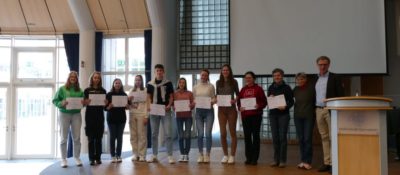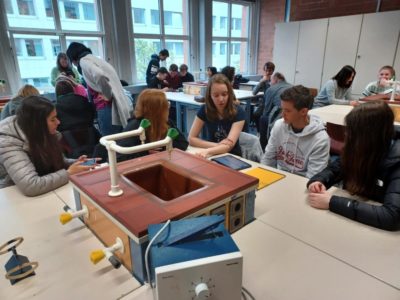Project coordinator at St. Stanislav’s: Alenka Battelino
Start date: 15. 12. 2020
End date: 14. 8. 2023
Coordinating Institution: Mallinckrodt-Gymnasium, Dortmund, Germany
Partner Institutions:
Sint-Jozefscollege, Torhout, Belgium
Institut Saint Dominique, Mortefontaine, France
SUGS Georgi Dimitrov, Skopje, Northern Macedonia
St. Stanislav’s Institution, Ljubljana, Slovenia
Wellington School, Ayr, Scotland
Project in the programme: Erasmus +, KA 2 (schools only)
General Description of the Project:
The environment, sustainability, global warming, biodiversity – these are topics which engage young people across the world; yet while many are ‘talking the talk’, they are not all ‘walking the walk’. This project aims to capture the interest of our students in the natural world and the environment and help them to make changes that will ensure the sustainable future that they are campaigning for. Although young people are worried about the future of our planet, many are not making the small changes in their lives that would help to safeguard the planet. Food waste, conspicuous consumption and reluctant recyclers are present in our schools in Belgium, France, Germany, Northern Macedonia, Slovenia and Scotland (UK). This project will encourage the small steps which can be taken by everyone for the good of all.
FUTUR€NVIRONMENT meeting at Institut Saint Dominique in Mortefotaine, France
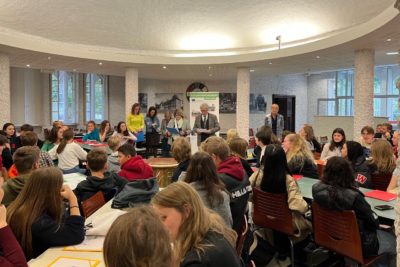
The meeting of partner schools participating in Erasmus+ KA2 project Futur€nvironment took place from 25th – 29th September 2022 in Mortefontaine, France. The hosting school was Institut Saint Dominique, with the following schools enjoying the hospitality of the French: Mallinckrodt-Gymnasium from Dortmund, Germany, which is the school coordinator of this project; Sint-Jozefscollege from Torhout, Belgium; SUGS Georgi Dimitrov from Skopje (Northern Macedonia), Wellington School, Ayr (Scotland) in St. Stanislav’s Institution with two teacher representatives, namely Alenka Battelino, Teacher of English and project coordinator, and Martin Čokl, teacher of physics.
This is how the Slovene students report on the event:
Monday, 26th October 2022
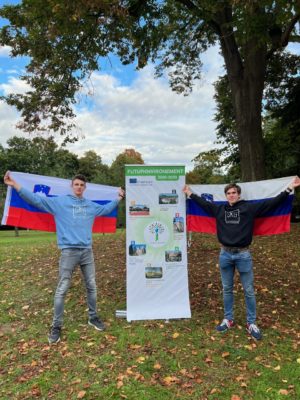
The morning after our first night abroad, we awoke in the pleasant safety of the homes of our hospitable French families. Then we ate an authentic French breakfast, which woke us up and gave us strength to start a new day. When we gathered in the dining room of the Institute of St. Dominic, we enthusiastically told each other about the first evening experiences. The program began with a speech by the headmaster of the institute, while he greeted us in French, we were able to follow his words with a help of a translator. A pleasant coffee break and snacks followed, after which we started with the workshops. The activities were environmentaly themed. After those, the mayor of Mortefonataine addressed and welcomed us into the village community. This was followed by a delicious snack.
After finishing we parted again and spent a pleasant evening with our friendly host families. /Rok Lekse, Filip Jeseničnik/
Tuesday, 27th October 2022:

The day began at Institut St. Dominic where the bus took us to a very special self-sufficient farm. There, we saw many different animals – pigs, a cow, chickens, ducks, sheep, goats, and two donkeys … Firstly they told us about the history of the farm, how they grow their vegetables, and take care of the animals. They also offered us their homemade fully natural apple juice and different fruit jams. Then the tour of their orchard and vegetable gardens followed. It was very interesting to learn that their farming techniques and products were completely natural – meaning they don’t use pesticides or chemical sprays. After the tour of the farm, we had some lunch and then went to the famous Paris.
Paris welcomed us with traffic jams, beautiful architecture, people from all around the world, and a very complicated language for us. From the bus, we could see Montmartre, The Eiffel Tower, L’Arc de Triomphe, L’Obélisque de Louxor, Place de la Concorde, La Défense, and Notre Dame de Paris. We also rode down the beautiful Champs Elysées, where we could slightly feel the city’s atmosphere. Then followed the guided tour of the Orsay museum where we admired the world-famous paintings and sculptures. After the museum, we strolled down the Parisian streets, took many photographs, and even crossed the Saine. This diverse day finished with some more traffic jam and a beautiful evening with our hosting families. /Lucija Kremžar, Klara Lesnik/
Wednesday, 28th October
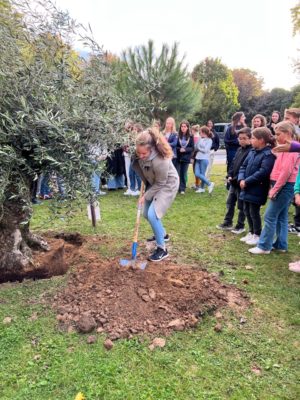
On Wednesday morning at half past eight, we gathered in the school dining room. We walked to the school hall, where Mr. Claude Lambre had a presentation about food additives contained in European foods and their dangers. After that there was a short coffee break and some snacks. We continued with workshops and attended the one called Life is still beautiful, where we met the art teacher Kathleen Ryan, who stuck precious stones over the moldy parts of the fruit. We glued glitter depicting mold onto preprepared styrofoam shapes. After the workshops, there was lunch, during which we chatted with students from other countries and had a little break. Before the start of the second part of the workshops, we took pictures with students from Belgium, Scotland, Macedonia and Germany. In the second part of the workshops, we baked a cake – Charlotte. Charlotte is a type of cake that can be served both cold or hot. Ours was made from apples. It was special because we actually used the whole apple, since we made syrup from the peels. After finishing the second part of the workshops, we took photos again, this time our hosts, the French pupils, joined us. Then, we all planted an olive tree together, to which everyone contributed a shovelful of soil. This was followed by a ceremonial presentation of awards for participation in the project. Then the celebratory dinner with a dance took place in the dining hall. At dinner, we were most impressed with the desserts. Among others, we were also served the cake we made at workshops. After dinner, we moved the tables and chairs aside and continued our evening of dancing. At about ten o’clock, after a beautiful and full day, we headed for the homes of our hosts. /Veronika Marc, Jerca Brolih, Lily Schweiger Kotar/
The Closing Student Exchange Visit in Germany – Futur€nvironment Project, Erasmus+
In the week of April when Earth Day is celebrated a group of students from the DCG took part in the student exchange taking place in Mallinckrodt Gymnasium in Dortmund, Germany from 18th to 22nd April 2023. This is how the participants themselves experienced this exciting event.
»On Tuesday morning we set off for Frankfurt, then continued to Dortmund by Germany’s fastest train. We arrived in Dortmund at around 6 pm, where we were met by our host families. We spent the evening in the warm embrace of their homes. On Wednesday morning we officially started our exchange at our partner school Mallinckrodt Gymnasium. The name of the project is Futur€nvironment, so our programme included topics and activities to raise awareness of environmental issues. We discussed pollution, global warming, carbon footprint and sustainable lifestyles. In the project were involved students from six countries; Germany, France, Belgium, Scotland, Macedonia and Slovenia.
First, we started with various icebreaking activities so we could get to know all the participants. We continued with a tour of the school. The Catholic school is located in the city centre and has more than 1000 students. It was named after Pauline von Mallinckrodt, a nun who played an important role in women’s education at the end of the 19th century.
In the morning, we took part in workshops. After lunch we went on a “selfie tour” of the city. In mixed groups, we discovered hidden corners of the city that contribute in their own way to sustainable development and a better quality of life. Dortmund is a relatively new city, having been destroyed by bomb attacks during WW II. It is one of Europe’s greenest cities, with many parks, tree plantations and gardens. Infrastructure is also modern, with the exception of a few old industrial buildings. /Iza and Eva, year 3/
On Thursday, we woke up to a slightly rainy morning, but that didn’t dampen our spirits, as we knew we had to make the most of every day. We gathered at school at 8 o’clock and headed to the atrium, where we were briefed on the day’s schedule. We had various workshops available, and some of us (Eva, Iza, and Jurij) continued with the Water Heroes workshop from Wednesday. Our relationship with water was examined and what we can do to keep it clean, while others participated in the Future of Energy workshop, and the rest in Let’s be Sustainable workshop. In the Future of Energy workshop, Zarja and Ajda, along with other participants, discussed the problems of using non-renewable sources of energy and their impact on the environment. They thought about alternative energy sources and the challenges we face in transitioning to greener energy sources. They wrote a letter to the European Union Commission to make them aware that young people care about the world they will live in. In the Let’s be Sustainable workshop, Anja, Ema, and Neža, along with others, first learned about what we can do ourselves for a better future, and then they recorded a DIY video showing their newly acquired knowledge, teaching us how to make our own waste bags from newspaper. Then came our favourite part of the day, snack time, followed by the second round of workshops. We had three different workshops available: Urban Future, DIY Shower Gel and Soap, and Design Your Own Jute Bag. At the Urban Future workshop, attended by Ema and Jurij, we saw how our cities could look in the future, and then the participants themselves designed and made their own “houses of the future,” which were then put on display. At the DIY Shower Gel and Soap workshop, Zarja, Anja, and Ajda learned something new about microplastics, which are found almost everywhere, even in shampoos and water. Then they made their own environmentally friendly shower gel. The last of the workshops was Design Your Own Jute Bag, where Eva, Iza, and Neža learned about the advantages of using sustainable bags and decorated their own reusable bag. We then had a brief summary of all the activities we had done, and then we headed to our hosts. /Jurij and Zarja, year 2/
On Friday morning, we took a bus to the Gasometer in Oberhausen, where we saw the fragile paradise exhibition. The exhibition was on three floors, and viewing the city and its surroundings from the roof was possible. The exhibition was held in a building in a form of a silo, which was intended for the storage of gases. It was written on the exhibition flyer that “The aim of the exhibition is to show the beauty of our planet, which is worth protecting, but it also means to draw attention to the abuses that threaten our paradise.” On the first floor there were various pictures of our planet, its biodiversity, and natural and cultural features. On the second floor there were pictures of our planet destroyed by global warming along with activities that pollute the environment presented in the form of pictures. However, measures and goals to prevent further warming were also displayed. On the 100 m high third floor there was a 20 m large model of the earth on which various videos were projected. We were able to observe the paths of planes and ships, the illumination of the earth at night due to cities, the formation of continents, the melting and formation of ice in the wider area of Antarctica and the Arctic and much more. The entire city of Essen and its surroundings could be seen from the top of the building.
Afterwards, we had lunch and then attended the closing ceremony. It started with watching the videos made at the various workshops in which we participated. All the products that were made were put on display. We looked at the products of different workshops then took each of our products and stored them. Having finished with this, we sat back and there was a presentation of all the people who participated, from students to teachers and hosts. Here we also received a certificate of attendance. A feast with juice and pizza followed. We had the last chance to say goodbye to students from some countries (Macedonia, some Germans), but others we were to see the next morning.
On Saturday we gathered at 9.30 in the morning, when our host families drove us to the hotel where our teachers were staying. There we said goodbyes and thanked them for everything they had done for us in the time of our visit. After that the teachers took us to the nearby Catholic church, were Mrs. Stenovec explained its characteristics. We came to the conclusion that the church was built in the Gothic style. After the short lecture we had a quick prayer and then we separated for our last adventure around Dortmund. At 13.55 we met at the hotel again and made our way to the train station. We spent some quality time, travelling around and getting to know Germany, which was great fun and interesting, but we were all looking forward to coming home. /Anja, Neža, Ema and Ajda, year 1; Lily Schweiger Kotar/
